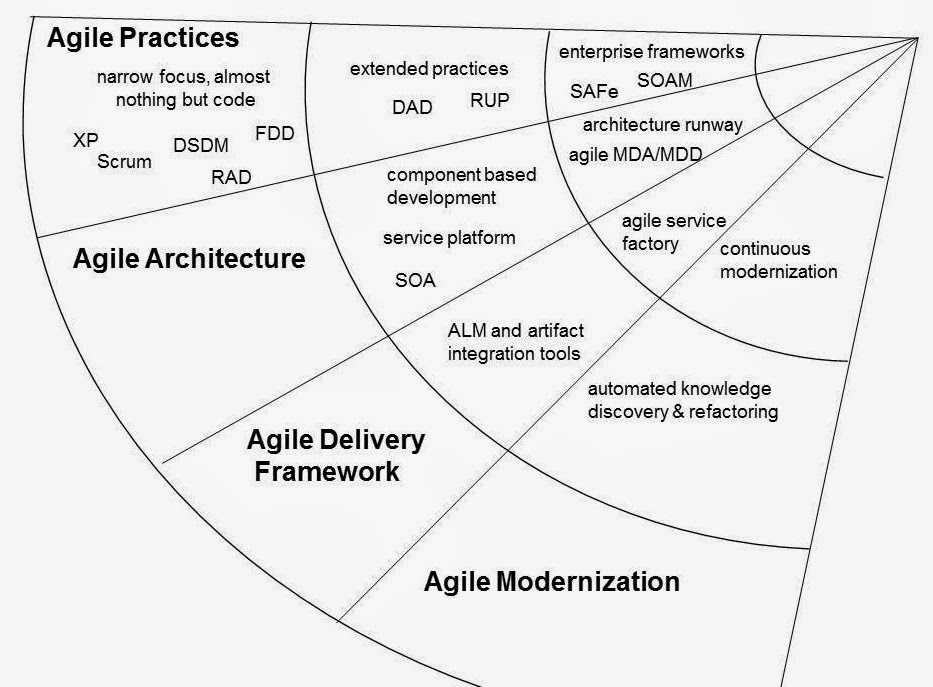I note healthy discussion around whether Agile is Dead [ref 1]. And while I may sympathize (sic) with many of the comments, particularly the commercial trivialization of education, the core issue must surely be the difficulty of adopting de facto Agile practices to support real world enterprise programs and projects. My experience is most of the advice and guidance out there is predicated on scaling the de facto Agile development methods. And this isn’t the best place to start.
An exception is Dean Leffingwell’s SAFe, [ref 2] which does introduce the idea of portfolio, program and project perspectives and intentional architecture. I recommend this framework as an intelligent set of practices, but for me it doesn’t go far enough because it is still primarily about development practices. This is the core problem – that Agile is development specific and practices only. In the enterprise, Agile development needs to be an integral part of a bigger ecosystem spanning business design, architecture, requirements, modernization and operational transformation practices plus architecture, delivery and modernization disciplines.
I am indebted to Dave Thomas whose recent blog, [ref 1] includes a worthy successor to the Agile Manifesto, reducing the original, development specific values and principles to a minimalist, more generic set. He says; “here is how to do something in an agile fashion”
– Find out where you are
– Take a small step towards your goal
– Adjust your understanding based on what you learned
– Repeat
And this is more useful in the enterprise context because it is relevant to a broader set of activities than purely software development.
The diagram below is an outline maturity model template for Agile in the enterprise. It suggests there are four key views that need to be part of the transformation. In addition to agile practices we need to be equally focused on what elements of agile architecture are required for an enterprise. What the agile delivery framework is and how the existing application portfolio will be modernized to progressively eliminate the duplication and complexity present in every enterprise on the planet.

People & Process. Much of the dissatisfaction with Agile arises from the limitations of the basic Agile practices, and the need to compromise these in an enterprise context. Both DAD and RUP (yes it’s an iterative method) are examples of extended or hybrid practices that introduce coordination, phasing and other disciplines that are more acceptable in enterprises that require traceability, governance and compliance with pre-existing life cycle practices. Enterprise frameworks such as Leffingwell’s SAFe as discussed and Everware-CBDI’s SOAM are examples of frameworks that adhere more closely to the purity of Agile principles while addressing enterprise specific needs. SAFe provides a framework which is more strongly Lean, coordinating portfolio, program and project activity to meet agile release train demand. SOAM provides a complementary, full life cycle process framework for software service modernization and delivery.
Agile Architecture. There is a requirement to articulate the enterprise requirements for agility as a reference architecture for business agility. In today’s fast moving world core architecture for the business, services, implementations, technology and deployments needs to be:
– under continuous development using Agile principles
– derived from the assessment of business needs for response to change, and constantly updated to reflect competitive and technology opportunities and threats.
– mapped to service architectures, patterns, policies and modernization strategies
– modeled using MDA/MDD to allow delivery as consistent architecture runways for portfolio and demand management, programs and projects.
Agile Delivery Framework. Most enterprises have a well-defined delivery framework of tools, repositories, templates etc that are designed to support well established QA and delivery policies. This is one of the most common inhibitors that Agile projects in the enterprise have to overcome. In an enterprise Agile context that framework must be realigned to provide maximum automation of life cycle management and governance so that key enterprise requirements for integrity can be met without loss of productivity. Similarly the development activity must be structured so that developers can extend the architecture runway with business solution specific rules and behaviors in a managed fashion which preserves the integrity of the architecture. Everware-CBDI has pioneered this runway extension capability implemented as a model driven (MDA/MDD) capability in which the runway code is generated and provided to developers enabling very significant productivity gains in both forward engineering and even more so in iteration.
Agile Modernization. Finally in an enterprise context the elephant in the room is the existing or legacy portfolio. Unless this elephant is addressed, the enterprise will continue to create more and more complexity, increase costs and reduce response times to change. What’s required is a discipline of continuous, Agile modernization. That means, using Dave Thomas’s minimalist manifesto [above] every portfolio item, program and project must include steps to find out the current situation and address minimum goals that reduce complexity and support a progressive modernization strategy. Without that, all enterprise Agile projects will remain narrow focus and simply add technical debt.
I suggest that while Agile is not dead in the enterprise it is certainly struggling to survive. This is because Agile practices alone will be suffocated at birth by enterprise realities of consistency and integrity; or turned into narrow focus, standalone projects; or morphed into BAU. I really don’t want to enter into a debate about nouns or verbs, life is too short. IMO Agile has considerable momentum and it can be morphed into a ground breaking concept that delivers enterprise business agility.
References
1 Agile is Dead (Long Live Agility)
2 Dean Leffingwell SAFe
